

Linked Data Patterns. Data strategy [WorldCat] Best Practices for Publishing Linked Data. Abstract This document sets out a series of best practices designed to facilitate development and delivery of open government data as Linked Open Data.
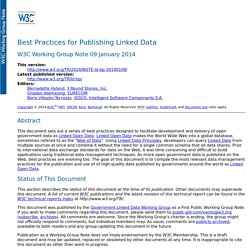
Linked Open Data makes the World Wide Web into a global database, sometimes refered to as the "Web of Data". Using Linked Data Principles, developers can query Linked Data from multiple sources at once and combine it without the need for a single common schema that all data shares. How Ontologies assist Linked Data Priciples. In the last instalment of my blog I introduced a Linked Data prototype application that exposes data of an SAP application as REST web service in semantic web standards so that it can be browsed with linked Data Browsers.

My attempt was to link online documentation of an ABAP application server to external, official documentation. This kind of links can help SAP users to navigate through the jungle of different documentation types. The most important aspect of this is that those links used for navigation are “typed” so that express a certain “meaning”. This can be a label that makes the property human readable. They can say that this is a link to normative and or perhaps non-normative documentation and much more. Semantalytics/awesome-semantic-web: A curated list of various semantic web and linked data resources. Linked Data Glossary. Bibliographic-Ontology-BIBO/bibo.owl at master · structureddynamics/Bibliographic-Ontology-BIBO. Karma: A Data Integration Tool. Linked Data for Professional Education – Learning resources tagged by competency. Try out RDF! - Introduction to Linked Data and the Semantic Web - University of Southampton.
Here you have a chance to write some RDF and check your understanding of how to express statements in this way.
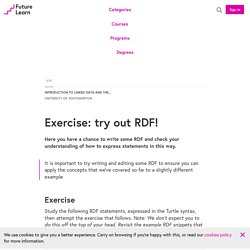
It is important to try writing and editing some RDF to ensure you can apply the concepts that we’ve covered so far to a slightly different example Exercise Study the following RDF statements, expressed in the Turtle syntax, then attempt the exercise that follows. Note: We don’t expect you to do this off the top of your head. Revisit the example RDF snippets that we’ve seen in the course so far, and then apply the syntax and structure rules that they use to this example.
@base < . We have developed an interactive exercise for you to use to try out RDF and check out your understanding. It is also strongly recommended that you revisit Step 1.9 and Step 1.10 and you read and / or print out the attached Exercise 1 worksheet & FAQs before you have a go at answering the following questions. Instructions on using the interactive exercise for questions 3. and 4. What is this ‘Linked Data’ thing all about? By Richard Light You may have come across an enthusiast (like me!)
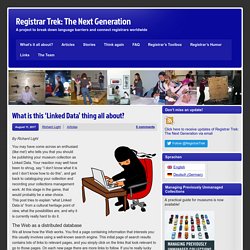
Who tells you that you should be publishing your museum collection as Linked Data. Your reaction may well have been to shrug, say “I don’t know what it is and I don’t know how to do this”, and get back to cataloguing your collection and recording your collections management work. At this stage in the game, that would probably be a wise choice. This post tries to explain “what Linked Data is” from a cultural heritage point of view, what the possibilities are, and why it is currently really hard to do it. Best Practices for Publishing Linked Data. Silk - The Linked Data Integration Framework. TaskForces/CommunityProjects/LinkingOpenData/DataSets. SWEO Community Project: Linking Open Data on the Semantic Web This page collects RDF data sets that are part of the emerging Web of Linked Data.
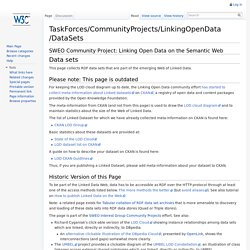
Please note: This page is outdated For keeping the LOD cloud diagram up to date, the Linking Open Data community effort has started to collect meta-information about Linked datasets on CKAN, a registry of open data and content packages provided by the Open Knowledge Foundation. The meta-information from CKAN (and not from this page) is used to draw the LOD cloud diagram and to maintain statistics about the size of the Web of Linked Data. The list of Linked Dataset for which we have already collected meta-information on CKAN is found here: CKAN LOD Group Basic statistics about these datasets are provided at: A guide on how to describe your dataset on CKAN is found here: LOD CKAN Guidlines. RDF AND JSON-LD UseCases - Data on the Web Best Practices. Author : Sumit Purohit, Mark Harrison Date : See History The collection of interrelated datasets on the Web is referred to as Linked Data and it can be used by various Semantic Web technologies (RDF, OWL, SKOS, SPARQL, etc.) that provide an environment where applications can query that data, draw inferences using vocabularies, etc [1] .
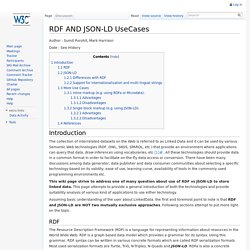
All these technologies should provide data in a common format in order to facilitate on-the-fly data access or conversion. There have been many discussions among data generator, data publisher and data consumer communities about selecting a specific technology based on its validity, ease of use, learning curve, availability of tools in the commonly used programming environments etc. Manchester Family History Advanced OWL Tutorial. A comprehensive step-by-step guide to modelling family history using advanced OWL 2 features.
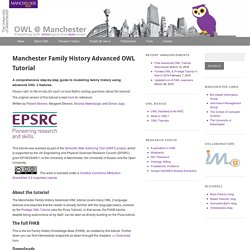
Please refer to the errata for each version before asking questions about the tutorial. The original version of this tutorial is kept here for reference. Written by Robert Stevens, Margaret Stevens, Nicolas Matentzoglu and Simon Jupp. This tutorial was realised as part of the Semantic Web Authoring Tool (SWAT) project, which is supported by the UK Engineering and Physical Sciences Research Council (EPSRC) grant EP/G032459/1, to the University of Manchester, the University of Sussex and the Open University.
This work is licensed under a Creative Commons Attribution-ShareAlike 3.0 Unported License. SameAs. HCLSIG/LODD/Data. LODD-related datasets that the LODD group already made available as Linked Data A graph of some of the LODD datasets (dark grey), related biomedical datasets (light grey), related general-purpose datasets (white) and their interconnections.
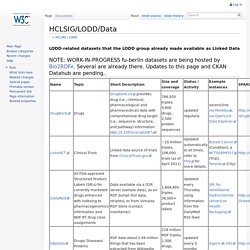
Line weights correspond to the number of links. The direction of an arrow indicates the dataset that contains the links, e.g., an arrow from A to B means that dataset A contains RDF triples that use identifiers from B. Bidirectional arrows usually indicate that the links are mirrored in both datasets. Linked Data Reactor. ImageSnippets – ImageSnippets. LibreCat/Catmandu data processing toolkit.
AddingRulesToOntologiesWithJena – Ontology Tutorial. Outline ¶ Tutorial set upJena Tutorial Program Functionality Tutorial Assignment This tutorial does not use Protege, but you might want to use it in conjunction with the tutorial to visualize the ontology.
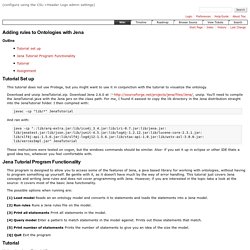
Download and unzip JenaTutorial.zip. Download Jena 2.6.0 at unzip. You'll need to compile the JenaTutorial.java with the Jena jars on the class path. Javac -cp "lib/*" JenaTutorial. RelFinder - Visual Data Web. Are you interested in how things are related with each other?

The RelFinder helps to get an overview: It extracts and visualizes relationships between given objects in RDF data and makes these relationships interactively explorable. Highlighting and filtering features support visual analysis both on a global and detailed level. The RelFinder is based on the open source framework Adobe Flex, easy-to-use and works with any RDF dataset that provides standardized SPARQL access. Ending the Invisible Library. To explain the utility of semantic search and linked data, Jeff Penka, director of channel and product development for information management solutions provider Zepheira, uses a simple exercise. Type “Chevy Chase” into Google’s search box, and in addition to a list of links, a panel appears on the right of the screen, displaying photos of the actor, a short bio, date of birth, height, full name, spouses and children, and a short list of movies and TV shows in which he has starred.
Continue typing the letters “ma” into the search box, and the panel instantly changes, showing images, maps, current weather, and other basic information regarding the town of Chevy Chase, MD. The panels are powered by Google’s Knowledge Graph, a massive knowledgebase that launched in May 2012 with “more than 500 million [data] objects” drawn from sources including Freebase, Wikipedia, and the CIA World Factbook, “as well as more than 3.5 billion facts about and relationships between these different objects.
Linked Data. OCLC has been working with Linked Data for several years. As can be seen from the publishing of the Dewey Decimal Classification (DDC), the Virtual International Authorities File (VIAF) and Faceted Application of Subject Terminology (FAST) as linked data. The release of experimental WorldCat Linked Data in June 2012 was another milestone in the exposure of WorldCat.org bibliographic metadata as linked data. The OCLC linked data strategy is an evolving mix of Linked Open Data (LOD) and Linked Enterprise Data (LED). This means that we will have incremental releases of new data and services, as we better understand how to model and publish the information.
Hyperthing - the Linked Data Validator. MO - the Movie Ontology. In the following, the movie ontology MO is described. The overview of the defined concepts are presented in Figure “Concept overview of the movie ontologyâ€. Overview of the movie ontology domain Movie related concepts. Linked Data Basics for Techies - OpenOrg. Intended Audience This is intended to be a crash course for a techie/programmer who needs to learn the basics ASAP. It is not intended as an introduction for managers or policy makers (I suggest looking at Tim Berners-Lee's TED talks if you want the executive summary).
It's primarily aimed at people who're tasked with creating RDF and don't have time to faff around. It will also be useful to people who want to work with RDF data. Understanding SKOS with an example. Ontology : TAPoR. TAPoR 3 Discover research tools for studying texts. Do You Know Your Company's Ontologies? Access Innovations. Q? What can I do with a taxonomy? A. You can use a taxonomy in many ways: Provide a common language basis for all activities within an organization.Coordinate documents, people, and activities by using the same descriptive terminology throughout.Categorize content (documents) using taxonomy terms.Search the data in your database by taxonomy term.Use taxonomy terms as metadata for HTML records.Use the taxonomy as a browsable topic list in a portal or web site.
An Introduction to the British National Bibliography – Lost Boy. This is the first of a series of posts (1, 2, 3, 4) providing background and tutorial material about the British National Bibliography. The British National Bibliography. A Linked Data Landscape. A Web of People and Machines: W3C Semantic Web Standards. It’s 1989. We are at CERN, the European Organization for Nuclear Research. Physicists and engineers from all over the world have gathered to seek answers about particle physics, bringing a variety of computers, file formats, software and procedures to the site. The inventor of the World Wide Web, Sir Tim Berners-Lee is also there for a brief consulting software job, working on a way to end the mess, caused by the incompatibility of formats, networks and systems.
Nature.com Ontologies. Dataset IRI | Applications | Diagram | Example. Using SPARQL to access Linked Open Data. Lesson Goals This lesson explains why many cultural institutions are adopting graph databases, and how researchers can access these data though the query language called SPARQL. PubChemRDF Release Notes. V1.6 beta (See the V1.5.2 beta Release Notes)Total number of triples: (last update on: )for more details, please see Table 2 1. PubChemRDF Release Notes. Ontologies. SearchFAST. Welcome to the new searchFAST user interface. This new interface simplifies the process of heading selection, in an easy to use one-page design. FAST subject headings were developed by adapting the Library of Congress Subject Headings (LCSH) with a simplified syntax, retaining the very rich vocabulary of LCSH while making the schema easier to understand, control, apply, and use.
The new interface design combines search box, brief results list, and full view of a selected record on a single page. Several indexes and the ability to restrict the result to a desired FAST facet increase searching accuracy. Linked Data Fragments. Getty Vocabularies LOD: Sample Queries. Ontology Classes. Linked Open Vocabularies. Untitled. CardioSHARE demo. Working with SPARQL in MarcEdit – Terry's Worklog. Feeds. Download SPARQL results into spreadsheet. SPARQL Endpoints List of URLs - Knowledge Center - Vocabulary. SPARQL Assist language-neutral query composer.
CardioSHARE demo. Home · edumbill/doap Wiki. Semast09-isaac. Term-based thesauri and SKOS (Part 1) Understanding SKOS with an example. RDF and OWL. VoiD.rkbexplorer.com. OOPS! – OntOlogy Pitfall Scanner! How to publish Linked Data on the Web. VoID. Globally Unique Identifier (GUID) The Quick Guide to GUIDs. Learning Linked Data: Making Your data harvestable via RDFa. How to create and publish a SKOS taxonomy in 5 minutes · AKSW/OntoWiki Wiki.
How to return SPARQL results in JSON-LD? Linked open data. Open Data Commons. Linked Data Platform Best Practices and Guidelines. Data on the Web Best Practices. Promote Your Content with Structured Data Markup - Structured Data. The New York Times Linked Open Data APIs: All the News That’s Fit to printf() New York Times - Linked Open Data. SameAs. RDF Validator. www.bl.uk/schemas/bibliographic/blterms. Rdf - N-Quad graphs - how do I use them? RDF 1.1 N-Quads. Basic Semantic Concepts. Getty Vocabularies as LOD. Data. Linked Data Basics for Techies - OpenOrg. Linked Data: Evolving the Web into a Global Data Space. SameAs.
Namespace lookup for RDF developers. Linked Data Platform 1.0. Welcome - the Datahub.